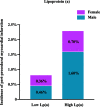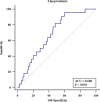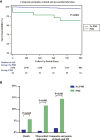Association Between Lipoprotein(a) and Peri-procedural Myocardial Infarction in Patients With Diabetes Mellitus Who Underwent Percutaneous Coronary Intervention
- PMID: 33613445
- PMCID: PMC7888338
- DOI: 10.3389/fendo.2020.603922
Association Between Lipoprotein(a) and Peri-procedural Myocardial Infarction in Patients With Diabetes Mellitus Who Underwent Percutaneous Coronary Intervention
Abstract
Background: High lipoprotein(a) (Lp[a]) levels are associated with increased risks of cardiovascular events in Percutaneous Coronary Intervention (PCI) patients with diabetes mellitus (DM). Peri-procedural myocardial infarction (PMI) occurs commonly during the PCI, whereas the relationship between Lp(a) and PMI remains unclear. Our study aimed to evaluate the association between Lp(a) value and the incidence of PMI in a larger-scale diabetic cohort undergoing PCI throughout 2013.
Methods: A total of 2,190 consecutive patients with DM were divided into two groups according to the median Lp(a) level of 175 mg/L: Low Lp(a) group (N = 1095) and high Lp(a) group (N = 1095). PMI was defined based on the 2018 universal definition of myocardial infarction.
Results: Patients with high Lp(a) levels exhibited higher rates of PMI compared to those with low Lp(a) levels (2.3% versus 0.8%, P = 0.006). The multivariable logistic analysis showed that PMI was independently predicted by Lp(a) as a dichotomous variable (OR 2.64, 95%CI 1.22-5.70) and as a continuous variable (OR 1.57, 95% CI 1.12-2.20). However, further investigation found that this association was only maintained in men, whose Lp(a) levels were significantly associated with the frequency of PMI, both as a dichotomous variable (OR 3.66, 95%CI 1.34-10.01) and as a continuous variable (OR 1.81, 95%CI 1.18-2.78). Lp(a) wasn't a risk factor of PMI in women.
Conclusions: High Lp(a) levels had forceful correlations with the increased frequency of PMI in male diabetic patients undergoing PCI. Lp(a) might act as a marker of risk stratification and a therapeutic target to reduce PCI-related ischemic events.
Keywords: coronary artery disease; diabetes mellitus; lipoprotein(a); percutaneous coronary intervention; peri-procedural myocardial infarction.
Copyright © 2021 Liu, Wang, Song, Zhang, Xu, Li, Shao, Yang, Chen and Tang.
Conflict of interest statement
The authors declare that the research was conducted in the absence of any commercial or financial relationships that could be construed as a potential conflict of interest.
Figures



References
-
- Damman P, Wallentin L, Fox KAA, Windhausen F, Hirsch A, Clayton T, et al. Long-Term Cardiovascular Mortality After Procedure-Related or Spontaneous Myocardial Infarction in Patients With Non–ST-Segment Elevation Acute Coronary Syndrome: A Collaborative Analysis of Individual Patient Data From the FRISC II, ICTUS, and RITA-3 Trials (FIR). Circulation (2012) 125:568–76. 10.1161/CIRCULATIONAHA.111.061663 - DOI - PubMed
Publication types
MeSH terms
Substances
LinkOut - more resources
Full Text Sources
Other Literature Sources
Medical
Miscellaneous

